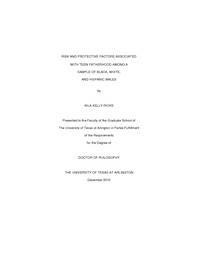
ATTENTION: The works hosted here are being migrated to a new repository that will consolidate resources, improve discoverability, and better show UTA's research impact on the global community. We will update authors as the migration progresses. Please see MavMatrix for more information.
Show simple item record
| dc.contributor.author | Kelly-Ricks, Nila | en_US |
| dc.date.accessioned | 2011-03-03T21:53:06Z | |
| dc.date.available | 2011-03-03T21:53:06Z | |
| dc.date.issued | 2011-03-03 | |
| dc.date.submitted | January 2010 | en_US |
| dc.identifier.other | DISS-11016 | en_US |
| dc.identifier.uri | http://hdl.handle.net/10106/5513 | |
| dc.description.abstract | After 14 years of consistent decline, the teen pregnancy rate increased for 2 consecutive years. This increase is concerning due to the adverse consequences associated with teen pregnancy. This study conducted secondary analysis with the 2007 Youth Risk Behavior Survey data. The Risk and Resilience Perspective guided this study to determine key factors associated with teen fatherhood. The overall purpose of the study was to investigate the key factors associated with teen fatherhood risk. Another purpose of the study was to provide pertinent information for pregnancy prevention programs. The sample consisted of 4588 adolescent males between the ages of 15 and 17. Of the 4588 males, 46% (n = 2120) were White , 32.5% (n = 1446) were Hispanic, and 22% (n = 1022) were Black. ANOVA analysis was used to compare mean scores on the investigator developed Teen Fatherhood Risk Scale among age and racial subgroups. The seven questions from the original survey that inquired about sexual behaviors were used to develop the risk scale. Linear regression was employed to assess whether or not the selected variables were predictors of teen fatherhood. Multiple regression was conducted to determine which variables remained significant in the face of other variables. Of the selected risk factors, race was the best predictor of teen fatherhood, followed by lifetime marijuana use. Being a minority increased risk scores by four points. Lifetime marijuana use increased risk scores by three points. Together these two risk factors accounted for 26% of the variance in risk scores. Of the selected protective factors, HIV/AIDS education was the best protector against teen fatherhood. HIV/AIDS education decreased risk scores by two points. Implications for teen pregnancy prevention specific to adolescent males and future research recommendations are presented. | en_US |
| dc.description.sponsorship | Woody, Debra | en_US |
| dc.language.iso | en | en_US |
| dc.publisher | Social Work | en_US |
| dc.title | Risk And Protective Factors Associated With Teen Fatherhood Among A Sample Of Black, White, And Hispanic Males | en_US |
| dc.type | Ph.D. | en_US |
| dc.contributor.committeeChair | Woody, Debra | en_US |
| dc.degree.department | Social Work | en_US |
| dc.degree.discipline | Social Work | en_US |
| dc.degree.grantor | University of Texas at Arlington | en_US |
| dc.degree.level | doctoral | en_US |
| dc.degree.name | Ph.D. | en_US |
Files in this item
- Name:
- KellyRicks_uta_2502D_11016.pdf
- Size:
- 848.7Kb
- Format:
- PDF
This item appears in the following Collection(s)
Show simple item record


